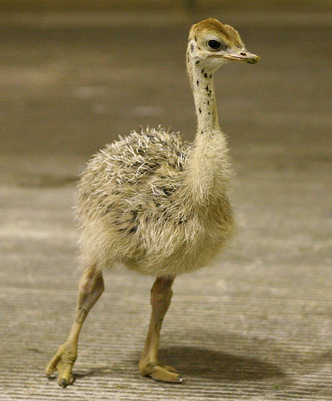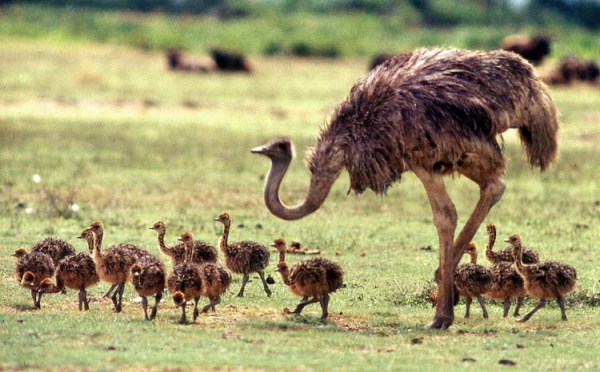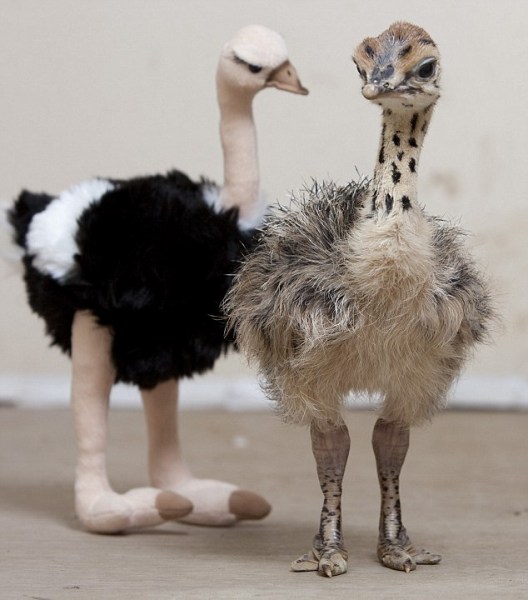Summary of issues: Career choice, female breadwinners, child care
I think this piece will be about one of my most talented art students who would like to pursue a creative career, but her dad wants her to be an engineer. His reasoning is that engineers have more stable earning power. I understand the need for financial independence, but I also find the need for woman to be equal or main bread-winners. There is also the obvious problem of the view that creative careers do not necessarily mean secure income.
The human-bird allegory of the ostrich is that they tag-team parent which according to Wolf (2013) is an accurate reflection of current parenting roles among university graduates. Wolf also writes about how education and job opportunities is changing whether women have children or not, how they raise them and when they have them. For example woman's increasing earning power allows them to raise children alone or with help from the state, which can afford to support single parents. Certain societies also provide state-funded nurseries which allow women to keep working. Wolf, also discusses how certain jobs are dominated by men or women for example caring for children is often a woman's job. This has given rise to what Wolf terms the new servant class which centres around executive women being able to pay others to care for their children. Time spent on housework and food-preparation has also been shortened by the fact that people purchase take-out or food produced factory workers who prepare food that can be served in under 30 minutes.
Another factor that Wolf cites as allowing women to hold executive jobs is the fact time use diaries show that men and women on average work the same amount of hours per work. However sometimes women feel like they work more because they tend to multi-task more than men.
writes that the book describes how "the 1960s development of modern highly educated professional females, (70 million worldwide) arose primarily due to the opening up of elite education for women, change of job opportunities, shift of family structures and the arrival of the birth control pill."
The author states that at present, among the new female elite, the best educated, most successful women’s’ child bearing age had changed dramatically. According to the statistics, the proportion of American women who stay childless has doubled since 1970s’. Educated women who have children have them later in their lives. During the first quarter of the 20th century, marriage meant end of employment for females. After mid 20th century, returning to work after marriage and child bearing became standard at a median age of 12 – 13 years. In the past decade, the median age to return to work after birth has reduced to less than 6 years. This trend is due to opportunities for modern women and professional success (Figure 1). The graduate mother today who postpones child bearing until thirty and then returns to work suffer no earning loss at all for her first child. The uneducated women, who have children earlier than educated women, don’t regret their choice."

Image from: / http://lirneasia.net/2014/02/the-xx-factor-how-working-women-are-creating-a-new-society-part-1/
Link on a Graph about income related to amount of children in society over 200 years
http://www.economist.com/blogs/economist-explains/2014/07/economist-explains-15
A juggler’s guide to having it all
| From the print edition
http://www.economist.com/news/business/21598669-bestand-worstplaces-be-working-woman-glass-ceiling-index/
David Manly writes the following about ostrich fathers:
"The Teachers
Ostriches
 There are many things that are peculiar about ostriches: their big eyes, the impressively large wingspan and the sheer size of their eggs. But one thing that most people are not aware of is that ostriches participate in true tag-team parenting.
There are many things that are peculiar about ostriches: their big eyes, the impressively large wingspan and the sheer size of their eggs. But one thing that most people are not aware of is that ostriches participate in true tag-team parenting.
After a female lays her eggs, the parents take turn incubating them: the female during the day, and the male at night. Zoologists believe that the male gets the night shift because, with his darker coloring, he will be less visible to predators and therefore be able to protect the nest better than the female.
Once the eggs hatch however, the male’s job has only just begun. He will fervently defend the hatchlings from predators, as well as teach them to feed. Not bad for an animal that many people still believe sticks their heads in the sand at any sign of trouble (for the record, they don’t)."
Information quoted from: http://blogs.scientificamerican.com/guest-blog/2011/06/19/good-dads-and-not-so-good-dads-in-the-animal-kingdom/
Thus my sculpture will discuss how women's working hours are no longer confined to the home and how this affects their child-rearing habits, career choice and life plans. Increase in female employment has also affected how one defines success, as being a successful woman is now judged by one's career achievements as well as one's mothering and home-making skills.Technical notes:
I think the baby ostriches' bodies will be made from clay and the legs and neck from wire. As you can see in my sample sculpture, the fragile neck has already broken. I am using straws to create holes for the neck and legs. I carved the wing texture with a 4H pencil and a pin.
Below are a collection of reference images...




Images above from: http://babyanimalzoo.com/baby-ostriches-even-the-largest-birds-start-out-as-little-chicks
Image from: http://www.photo-dictionary.com/phrase/4876/baby-ostrich.html
image from: http://www.panoramio.com/photo/5900215
.jpg)

Images above from http://www.northrup.org/photos/ostrich/
Female Engineers Reference Images:
Coo, D. (2013). NerdScholar’s Favorite Women in Engineering Programs | NerdScholar. [online] Nerdwallet.com. Available at: http://www.nerdwallet.com/blog/nerdscholar/2013/nerdscholars-favorite-women-engineering-programs/ [Accessed 17 Jul. 2014].
Haut, Y. (2012). List Of Engineering Colleges Malaysia 2014, Private Colleges, Scholarships 2014, Top Colleges 2014, Automobile Colleges 2014 » Should A Girl Study Engineering?. [online] Engineeringcollegesmalaysia.com. Available at: http://engineeringcollegesmalaysia.com/2012/01/should-a-girl-study-engineering/ [Accessed 17 Jul. 2014].
Steel mesh:
http://www.shutterstock.com/s/%22wire+mesh+%22/search.html
R100 Note image:

http://www.southafricaexplorer.co.za/articles/south-african-currency.html

http://www.zastavki.com/eng/People/Children/wallpaper-23259.htm

image from: http://www.sagestone-partners.com/untitled1.html

image from: http://en.wikipedia.org/wiki/Drawing_board
http://www.zastavki.com/eng/People/Children/wallpaper-23259.htm

image from: http://www.sagestone-partners.com/untitled1.html
image from: http://en.wikipedia.org/wiki/Drawing_board
Bibliography
Alpher, D. (2013). Guilt and The XX Factor. [online] Daniella Alpher. Available at: http://daniellaalpher.com/2013/10/08/guilt-and-the-xx-factor/ [Accessed 11 Jul. 2014].
Manly, D. (2011). Good Dads and Not-So-Good Dads in the Animal Kingdom | Guest Blog, Scientific American Blog Network. [online] Blogs.scientificamerican.com. Available at: http://blogs.scientificamerican.com/guest-blog/2011/06/19/good-dads-and-not-so-good-dads-in-the-animal-kingdom/ [Accessed 11 Jul. 2014].
Miln-Tyte, A. (2013). SoundCloud - Hear the world’s sounds. [online] SoundCloud. Available at: https://soundcloud.com/broadexperience/the-broad-experience-27-rise [Accessed 11 Jul. 2014].
Senanayake, L. (2014). The XX Factor: How working women are creating a new society (Part 1) » LIRNEasia - a regional ICT policy and regulation think tank active across the Asia Pacific. [online] Lirneasia.net. Available at: http://lirneasia.net/2014/02/the-xx-factor-how-working-women-are-creating-a-new-society-part-1/ [Accessed 11 Jul. 2014].
The Economist, (2014). Why Swedish men take so much paternity leave. [online] Available at: http://www.economist.com/blogs/economist-explains/2014/07/economist-explains-15 [Accessed 29 Jul. 2014].
The Economist, (2014). The glass-ceiling index. [online] Available at: http://www.economist.com/news/business/21598669-bestand-worstplaces-be-working-woman-glass-ceiling-index/ [Accessed 29 Jul. 2014].
The Economist, (2014). Baby blues. [online] Available at: http://www.economist.com/node/21539925 [Accessed 29 Jul. 2014].




No comments:
Post a Comment